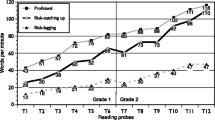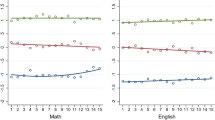Abstract
Michigan’s Great Start Readiness Program (GSRP) is a state-funded pre-K program that serves at risk four-year-old children across the state. Utilizing longitudinal data from 1,394 children in a mid-sized urban school district, we conducted regression analyses and piecewise linear growth models to examine the growth trajectory of GSRP children and non-GSRP children at each grade level from kindergarten to third grade in both reading and math. The results of regression analyses showed that, after accounting for other variables, participation in GSRP was statistically significantly associated with higher scores on Measure of Academic Progress (MAP) measures at various time points, ranging from 0.22–0.46 standard deviations (SD) in math and 0.31–0.49 SD in reading. The results of piecewise linear growth models illustrated that GSRP children had a statistically significantly faster monthly growth rate than non-GSRP children during the kindergarten year. However, the growth rates were not significantly different during the first, second, and third grade.
Similar content being viewed by others
Notes
It is important to note that these five cohorts of students were affected by COVID-19 to vary degrees. The 2017–18 and 2018–19 cohorts were not impacted by COVID-19. However, due to COVID-19, the Spring MAP tested was not conducted during the 2019–2020 school year when the 2019–20 cohort was in third grade, the 2020–21 cohort was in second grade, and the 2021–21 cohort was in first grade.
It would be more ideal to have Fall, Winter, and Spring achievement data for each grade, but these six measures are the only data available for us to use.
We lack information about the specific schools attended by students within the school district, rendering a three-level model with repeated measures nested within students nested within schools unfeasible. Additionally, the elementary schools within the district are few in number.
References
Ansari, A., Lόpez, M., Manfra, L., Bleiker, C., Dinehart, L. H., Hartman, S. C., & Winsler, A. (2017). Differential third-grade outcomes associated with attending publicly funded preschool programs for low-income Latino children. Child Development, 88(5), 1743–1756.
Barnett, W. S. (2011). Effectiveness of early educational intervention. Science, 333(6045), 975–978. https://doi.org/10.1126/science.1204534
Barnett, W. S., & Jung, K. (2021). Effects of New Jersey’s Abbott preschool program on children’s achievement, grade retention, and special education through tenth grade. Early Childhood Research Quarterly, 56, 248–259. https://doi.org/10.1016/j.ecresq.2021.04.001
Barnett, W. S., Jung, K., Friedman-Krauss, A., Frede, E. C., Nores, M., Hustedt, J. T., Howes, C., & Daniel-Echols, M. (2018). State prekindergarten effects on early learning at kindergarten entry: An analysis of eight state programs. AERA Open, 4(2), 1–16. https://doi.org/10.1177/2332858418766291
Blau, D. M. (2021). The effects of universal preschool on child and adult outcomes: A review of recent evidence from Europe with implications for the United States. Early Childhood Research Quarterly, 55, 52–63. https://doi.org/10.1016/j.ecresq.2020.10.009
Burchinal, M., Magnuson, K., Powell, D., & Hong, S. S. (2015). Early childcare and education. In M. H. Bornstein, T. Leventhal, & R. M. Lerner (Eds.), Handbook of child psychology and developmental science: Ecological settings and processes (pp. 223–267). John Wiley & Sons Inc.
Camilli, G., Vargas, S., Ryan, S., & Barnett, W. S. (2010). Meta-analysis of the effects of early education interventions on cognitive and social development. Teachers College Record, 112(3), 579–620.
Campbell, F. A., Ramey, C. T., Pungello, E., Sparling, J., & Miller-Johnson, S. (2002). Early childhood education: Young adult outcomes from the Abecedarian Project. Applied Developmental Science, 6(1), 42–57.
Durkin, K., Lipsey, M. W., Farran, D. C., & Wiesen, S. E. (2022). Effects of a statewide pre-kindergarten program on children’s achievement and behavior through sixth grade. Developmental Psychology, 58(3), 470–484. https://doi.org/10.1037/dev0001301
Feister, L. (2013). Early warning confirmed: A research update on third-grade reading. The Annie E. Casey Foundation. Retrieved May 5, 2024 from https://assets.aecf.org/m/resourcedoc/AECF-EarlyWarningConfirmed-2013.pdf
Gormley, W. T., Jr., Gayer, T., Phillips, D., & Dawson, B. (2005). The effects of universal pre-K on cognitive development. Developmental Psychology, 41(6), 872–884. https://doi.org/10.1037/0012-1649.41.6.872
Gormley, W. T., Phillips, D., & Gayer, T. (2008). Preschool programs can boost school readiness. Science, 320(5884), 1723–1724. https://doi.org/10.1126/science.1156019
Gray-Lobe, G., Pathak, P. A., & Walters, C. R. (2023). The long-term effects of universal preschool in Boston. The Quarterly Journal of Economics, 138(1), 363–411. https://doi.org/10.1093/qje/qjac036
Harden, B. J., Brett, B. E., Gross, J. T., Weiland, C., Berne, J., Klein, E. L., & Tirrell-Corbin, C. (2023). Benefits of pre-kindergarten for children in Baltimore, MD. Early Childhood Research Quarterly, 64, 1–12. https://doi.org/10.1016/j.ecresq.2023.01.011
Hernandez, D. J. (2011). Double jeopardy: How third-grade reading skills and poverty influence high school graduation. Annie E. Casey Foundation. Retrieved May 5, 2024 from https://files.eric.ed.gov/fulltext/ED518818.pdf
Hill, C. J., Gormley, W. T., & Adelstein, S. (2015). Do the short-term effects of a high-quality preschool program persist? Early Childhood Research Quarterly, 32, 60–79. https://doi.org/10.1016/j.ecresq.2014.12.005
Huang, F. L. (2017). Does attending a state-funded preschool program improve letter name knowledge? Early Childhood Research Quarterly, 38, 116–126. https://doi.org/10.1016/j.ecresq.2016.08.002
Huang, F. L., Invernizzi, M. A., & Drake, E. A. (2012). The differential effects of preschool: Evidence from Virginia. Early Childhood Research Quarterly, 27(1), 33–45. https://doi.org/10.1016/j.ecresq.2011.03.006
Kraft, M. A. (2020). Interpreting effect sizes of education interventions. Educational Researcher, 49(4), 241–253. https://doi.org/10.3102/0013189X20912798
Lesnick, J., Goerge, R., Smithgall, C., & Gwynne J. (2010). Reading on grade level in third grade: How is it related to high school performance and college enrollment? Chapin Hall at the University of Chicago. https://eric.ed.gov/?id=ED517805
Lipsey, M. W., Farran, D. C., & Durkin, K. (2018). Effects of the Tennessee Prekindergarten Program on children’s achievement and behavior through third grade. Early Childhood Research Quarterly, 45, 155–176.
Magnuson, K. A., Ruhm, C., & Waldfogel, J. (2007). Does prekindergarten improve school preparation and performance? Economics of Education Review, 26(1), 33–51.
McCoy, D. C., Yoshikawa, H., Ziol-Guest, K. M., Duncan, G. J., Schindler, H. S., Magnuson, K., Yang, R., Koepp, A., & Shonkoff, J. P. (2017). Impacts of early childhood education on medium- and long-term educational outcomes. Educational Researcher, 46(8), 474–487. https://doi.org/10.3102/0013189X17737739
Michigan Department of Education. (2023). GSRP Implementation Manual. Michigan Department of Education. Retrieved May 5, 2024 from https://www.michigan.gov/-/media/Project/Websites/mileap/Documents/Early-Childhood-Education/gsrp/implementation/implementation_manual.pdf?rev=0ec96c4ac6b4459884b12c1a4a3ceecb
Montrosse-Moorhead, B., Dougherty, S. M., La Salle, T. P., Weiner, J. M., & Dostal, H. M. (2019). The overall and differential effects of a targeted prekindergarten program: Evidence from Connecticut. Early Childhood Research Quarterly, 48, 134–145. https://doi.org/10.1016/j.ecresq.2019.02.006
National Institute for Early Education Research. (2022). The state of preschool 2021. Retrieved May 5, 2024 from https://nieer.org/sites/default/files/2023-10/YB2021_Full_Report.pdf
National Institute for Early Education Research. (2023). The state of preschool 2022. Retrieved May 5, 2024 from https://nieer.org/sites/default/files/2023-09/yb2022_fullreport.pdf
NICHD Early Child Care Research Network (Ed.). (2005). Child care and child development: Results from the NICHD study of early child care and youth development. Guilford Press
Peisner-Feinberg, E. S., Burchinal, M. R., Clifford, R. M., Culkin, M. L., Howes, C., Kagan, S. L., & Yazejian, N. (2001). The relation of preschool child-care quality to children’s cognitive and social developmental trajectories through second grade. Child Development, 72(5), 1534–1553.
Raudenbush, S. W. & Bryk, A. S. (2002). Hierarchical linear models: Applications and data analysis methods. Sage Publication.
Raver, C. C., Jones, S. M., Li-Grining, C. P., Metzger, M., Champion, K. M., & Sardin, L. (2008). Improving preschool classroom processes: Preliminary findings from a randomized trial implemented in Head Start settings. Early Childhood Research Quarterly, 23(1), 10–26.
Schweinhart, L. J., Barnes, H. V., & Weikhart, D. P. (2005). Significant benefits: The High/Scope Perry preschool study through age 27. In N. Frost (Ed.), Child welfare: Major themes in health and social welfare (pp. 9–29). Routledge.
Schweinhart, L. J., Xiang, Z., Daniel-Echols, M., Browning, K., & Wakabayashi, T. (2012). Michigan Great Start Readiness Program evaluation 2012: High school graduation and grade retention findings. HighScope Educational Research Foundation. Retrieved May 5, 2024 from https://highscope.org/wp-content/uploads/2018/03/gsrp-2012-report.pdf
Sulik, M. J., Townley-Flores, C., Steyer, L., & Obradović, J. (2023). Impacts of two public preschool programs on school readiness in San Francisco. Early Childhood Research Quarterly, 62, 194–205. https://doi.org/10.1016/j.ecresq.2022.07.016
Weiland, C., Unterman, R., Shapiro, A., Staszak, S., Rochester, S., & Martin, E. (2020). The effects of enrolling in oversubscribed prekindergarten programs through third grade. Child Development, 91(5), 1401–1422. https://doi.org/10.1111/cdev.13308
Wu, J. H., Akaeze, H. O. & Shereda, A. (2021). Michigan public preschools improve kindergarten readiness: Findings from the Michigan Great Start Readiness Program (GSRP). GSRP state evaluation fact sheet. Michigan State University. Retrieved May 5, 2024 from https://cep.msu.edu/upload/documents/KRA_3rd%20version_FINAL.pdf
Wu, J. H., Weber, E., Herbowicz, T., Van Egeren, L. A. & Akaeze, H. O. (2022). Great Start Readiness Program State Evaluation 2021–22 Annual Report. Michigan State University. Retrieved May 5, 2024 from https://cep.msu.edu/upload/gsrp/Great%20Start%20Readiness%20Program%20State%20Evaluation%202020-21%20Annual%20Report.pdf
Xiang, Z. & Wakabayashi, T. (2014). Michigan Great Start Readiness Program Evaluation: Lansing School District 2011–2014—Group Equivalency Enhanced Regression Discontinuity Design. Unpublished report submitted to Michigan Department of Education.
Yoshikawa, H., Weiland, C., Brooks-Gunn, J., Burchinal, M. R., Espinosa, L. M., Gormley, W. T., Ludwig, J., Magnuson, K., Phillips, D., & Zaslow, M. J. (2013). Investing in our future: The evidence base on preschool education. Society for Research in Child Development.
Author information
Authors and Affiliations
Corresponding author
Additional information
Publisher's Note
Springer Nature remains neutral with regard to jurisdictional claims in published maps and institutional affiliations.
Appendices
Appendix A
Table 5
Appendix B
Table 6
Rights and permissions
Springer Nature or its licensor (e.g. a society or other partner) holds exclusive rights to this article under a publishing agreement with the author(s) or other rightsholder(s); author self-archiving of the accepted manuscript version of this article is solely governed by the terms of such publishing agreement and applicable law.
About this article
Cite this article
Wu, H., Shen, J., Li, X. et al. Great Start Readiness Program and Children’s Academic Achievement: A Longitudinal Study. Early Childhood Educ J (2024). https://doi.org/10.1007/s10643-024-01680-2
Accepted:
Published:
DOI: https://doi.org/10.1007/s10643-024-01680-2




